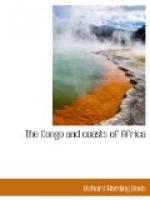Sierra Leone, as originally purchased in 1786, consisted of twenty square miles, for which among other articles of equal value King Naimbanna received a “crimson satin embroidered waistcoat, one puncheon of rum, ten pounds of beads, two cheeses, one box of smoking pipes, a mock diamond ring, and a tierce of pork.”
What first impressed me about Sierra Leone was the heat. It does not permit one to give his attention wholly to anything else. I always have maintained that the hottest place on earth is New York, and I have been in other places with more than a local reputation for heat; some along the Equator, Lourenco Marquez, which is only prevented from being an earthen oven because it is a swamp; the Red Sea, with a following breeze, and from both shores the baked heat of the desert, and Nagasaki, on a rainy day in midsummer.
But New York in August radiating stored-up heat from iron-framed buildings, with the foul, dead air shut in by the skyscrapers, with a humidity that makes you think you are breathing through a steam-heated sponge, is as near the lower regions as I hope any of us will go. And yet Sierra Leone is no mean competitor.
We climbed the moss-covered steps to the quay to face a great white building that blazed like the base of a whitewashed stove at white heat. Before it were some rusty cannon and a canoe cut out of a single tree, and, seated upon it selling fruit and sun-dried fish, some native women, naked to the waist, their bodies streaming with palm oil and sweat. At the same moment something struck me a blow on the top of the head, at the base of the spine and between the shoulder blades, and the ebony ladies and the white “factory” were burnt up in a scroll of flame.
[Illustration: A White Building, that Blazed
Like the Base of a
Whitewashed Stove at White Heat.]
I heard myself in a far-away voice asking where one could buy a sun helmet and a white umbrella, and until I was under their protection, Sierra Leone interested me no more.




